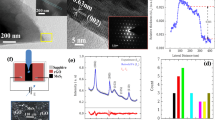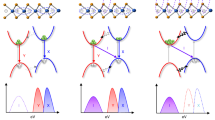Abstract
The piezoelectric characteristics of nanowires, thin films and bulk crystals have been closely studied for potential applications in sensors, transducers, energy conversion and electronics1,2,3. With their high crystallinity and ability to withstand enormous strain4,5,6, two-dimensional materials are of great interest as high-performance piezoelectric materials. Monolayer MoS2 is predicted to be strongly piezoelectric, an effect that disappears in the bulk owing to the opposite orientations of adjacent atomic layers7,8. Here we report the first experimental study of the piezoelectric properties of two-dimensional MoS2 and show that cyclic stretching and releasing of thin MoS2 flakes with an odd number of atomic layers produces oscillating piezoelectric voltage and current outputs, whereas no output is observed for flakes with an even number of layers. A single monolayer flake strained by 0.53% generates a peak output of 15 mV and 20 pA, corresponding to a power density of 2 mW m−2 and a 5.08% mechanical-to-electrical energy conversion efficiency. In agreement with theoretical predictions, the output increases with decreasing thickness and reverses sign when the strain direction is rotated by 90°. Transport measurements show a strong piezotronic effect in single-layer MoS2, but not in bilayer and bulk MoS2. The coupling between piezoelectricity and semiconducting properties in two-dimensional nanomaterials may enable the development of applications in powering nanodevices, adaptive bioprobes and tunable/stretchable electronics/optoelectronics.
This is a preview of subscription content, access via your institution
Access options
Subscribe to this journal
Receive 51 print issues and online access
$199.00 per year
only $3.90 per issue
Buy this article
- Purchase on Springer Link
- Instant access to full article PDF
Prices may be subject to local taxes which are calculated during checkout




Similar content being viewed by others
References
Kingon, A. I. & Srinivasan, S. Lead zirconate titanate thin films directly on copper electrodes for ferroelectric, dielectric and piezoelectric applications. Nature Mater. 4, 233–237 (2005)
Ferren, R. A. Advances in polymeric piezoelectric transducers. Nature 350, 26–27 (1991)
Wang, Z. L. & Song, J. H. Piezoelectric nanogenerators based on zinc oxide nanowire arrays. Science 312, 242–246 (2006)
Lee, C., Wei, X. D., Kysar, J. W. & Hone, J. Measurement of the elastic properties and intrinsic strength of monolayer graphene. Science 321, 385–388 (2008)
Lee, G. H. et al. High-strength chemical-vapor deposited graphene and grain boundaries. Science 340, 1073–1076 (2013)
Bertolazzi, S., Brivio, J. & Kis, A. Stretching and breaking of ultrathin MoS2 . ACS Nano 5, 9703–9709 (2011)
Duerloo, K. A. N., Ong, M. T. & Reed, E. J. Intrinsic piezoelectricity in two-dimensional materials. J. Phys. Chem. Lett. 3, 2871–2876 (2012)
Michel, K. H. & Verberck, B. Phonon dispersions and piezoelectricity in bulk and multilayers of hexagonal boron nitride. Phys. Rev. B 83, 115328 (2011)
Yang, R. S., Qin, Y., Dai, L. M. & Wang, Z. L. Power generation with laterally packaged piezoelectric fine wires. Nature Nanotechnol. 4, 34–39 (2009)
Ong, M. T. & Reed, E. J. Engineered piezoelectricity in graphene. ACS Nano 6, 1387–1394 (2012)
Michel, K. H. & Verberck, B. Theory of elastic and piezoelectric effects in two-dimensional hexagonal boron nitride. Phys. Rev. B 80, 224301 (2009)
Mak, K. F., He, K. L., Shan, J. & Heinz, T. F. Control of valley polarization in monolayer MoS2 by optical helicity. Nature Nanotechnol. 7, 494–498 (2012)
Zeng, H. L., Dai, J. F., Yao, W., Xiao, D. & Cui, X. D. Valley polarization in MoS2 monolayers by optical pumping. Nature Nanotechnol. 7, 490–493 (2012)
Kumar, N. et al. Second harmonic microscopy of monolayer MoS2 . Phys. Rev. B 87, 161403 (2013)
Malard, L. M., Alencar, T. V., Barboza, A. P. M., Mak, K. F. & de Paula, A. M. Observation of intense second harmonic generation from MoS2 atomic crystals. Phys. Rev. B 87, 201401 (2013)
Li, Y. L. et al. Probing symmetry properties of few-layer MoS2 and h-BN by optical second-harmonic generation. Nano Lett. 13, 3329–3333 (2013)
Wang, Q. H., Kalantar-Zadeh, K., Kis, A., Coleman, J. N. & Strano, M. S. Electronics and optoelectronics of two-dimensional transition metal dichalcogenides. Nature Nanotechnol. 7, 699–712 (2012)
Conley, H. J. et al. Bandgap engineering of strained monolayer and bilayer MoS2 . Nano Lett. 13, 3626–3630 (2013)
Dean, C. R. et al. Boron nitride substrates for high-quality graphene electronics. Nature Nanotechnol. 5, 722–726 (2010)
He, K., Poole, C., Mak, K. F. & Shan, J. Experimental demonstration of continuous electronic structure tuning via strain in atomically thin MoS2 . Nano Lett. 13, 2931–2936 (2013)
Neal, A. T., Liu, H., Gu, J. J. & Ye, P. D. in Conference Digest, Device Research Conference (DRC), 18–20 June 2012 70th Annual 65–66, http://dx.doi.org/10.1109/DRC.2012.6256928 (IEEE, 2012)
Wang, Z. L. Piezopotential gated nanowire devices: piezotronics and piezo-phototronics. Nano Today 5, 540–552 (2010)
Hu, Y. F. et al. Temperature Dependence of the Piezotronic Effect in ZnO Nanowires. Nano Lett. 13, 5026–5032 (2013)
Chen, J. R. et al. Control of Schottky barriers in single layer MoS2 transistors with ferromagnetic contacts. Nano Lett. 13, 3106–3110 (2013)
Yang, H. et al. Graphene barristor, a triode device with a gate-controlled Schottky barrier. Science 336, 1140–1143 (2012)
Huang, M. Y., Pascal, T. A., Kim, H., Goddard, W. A. & Greer, J. R. Electronic-mechanical coupling in graphene from in situ nanoindentation experiments and multiscale atomistic simulations. Nano Lett. 11, 1241–1246 (2011)
van der Zande, A. M. et al. Grains and grain boundaries in highly crystalline monolayer molybdenum disulphide. Nature Mater. 12, 554–561 (2013)
Lauritsen, J. V. et al. Size-dependent structure of MoS2 nanocrystals. Nature Nanotechnol. 2, 53–58 (2007)
Wu, W. Z., Wen, X. N. & Wang, Z. L. Taxel-addressable matrix of vertical-nanowire piezotronic transistors for active and adaptive tactile imaging. Science 340, 952–957 (2013)
Wang, Z. L. & Wu, W. Z. Nanotechnology-enabled energy harvesting for self-powered micro-/nanosystems. Angew. Chem. Int. Ed. 51, 11700–11721 (2012)
Landau, L. D., Lifshits, E. M., Kosevich, A., d. M & Pitaevskiĭ, L. P. Theory of Elasticity 3rd English edn (Pergamon, 1986)
Cooper, R. C. et al. Nonlinear elastic behavior of two-dimensional molybdenum disulfide. Phys. Rev. B 87, 035423 (2013)
He, K., Poole, C., Mak, K. F. & Shan, J. Experimental demonstration of continuous electronic structure tuning via strain in atomically thin MoS2 . Nano Lett. 13, 2931–2936 (2013)
Conley, H. et al. Bandgap engineering of strained monolayer and bilayer MoS2 . Nano Lett. 13, 3626–3630 (2013)
Hui, Y. Y. et al. Exceptional tunability of band energy in a compressively strained trilayer MoS2 sheet. ACS Nano 7, 7126–7131 (2013)
Johari, P. & Shenoy, V. B. Tuning the electronic properties of semiconducting transition metal dichalcogenides by applying mechanical strains. ACS Nano 6, 5449–5456 (2012)
Zhang, Y., Liu, Y. & Wang, Z. L. Fundamental theory of piezotronics. Adv. Mater. 23, 3004–3013 (2011)
Gao, Y. F. & Wang, Z. L. Equilibrium potential of free charge carriers in a bent piezoelectric semiconductive nanowire. Nano Lett. 9, 1103–1110 (2009)
Hu, Y. F., Lin, L., Zhang, Y. & Wang, Z. L. Replacing a battery by a nanogenerator with 20 V output. Adv. Mater. 24, 110–114 (2012)
Acknowledgements
We thank C. Dean, P. Kim and K. Shepard for discussions, and K. Alexander and E. Reed for theoretical consultation. This research was supported by the US Department of Energy, Office of Basic Energy Sciences (DE-FG02-07ER46394) and US National Science Foundation (DMR-1122594). Z.L.W. acknowledges the ‘Thousands Talents’ programme for pioneer researcher and his innovation team, National Natural Science Foundation of China (51432005), and China and Beijing City Committee of Science and Technology (Z131100006013004 and Z131100006013005).
Author information
Authors and Affiliations
Contributions
W.Z.W., L.W., Z.L.W. and J.H. conceived the idea. W.Z.W., L.W., Y.L.L., T.F.H., J.H. and Z.L.W. designed the experiments. L.W., D.C., F.Z. and Y.F.H. synthesized the material. L.W., D.C. and W.Z.W. fabricated the devices. Y.L.L. performed the SHG characterization. W.Z.W., L.W., L.L., Y.L.L. and S.M.N. conducted the experiments. W.Z.W., L.W., J.H. and Z.L.W. analysed the data and wrote the manuscript.
Corresponding authors
Ethics declarations
Competing interests
The authors declare no competing financial interests.
Extended data figures and tables
Extended Data Figure 1 Raman spectrum of MoS2 flakes and setup for SHG measurement.
a, Raman spectrum of MoS2 flakes with different layer numbers. b, Experimental setup for the SHG measurement.
Extended Data Figure 2 Mechanical strain applied to MoS2 device.
a, Schematic drawing for estimating strain in MoS2 device. b, Schematic plot of strain driving signal from linear motor. c, Typical configurations for linear motor.
Extended Data Figure 4 Mechanism of electrical power generation in single-layer MoS2 due to the flow of electrons in external load driven by piezoelectric polarization charges.
The equivalent circuit of the piezoelectric nanogenerator is also shown.
Extended Data Figure 5 Piezoelectric output of MoS2 device with different strain parameters.
a, Short-circuit current–strain and open-circuit voltage–strain hysteresis loops. Hold time t1 = t2 = 1 s and acceleration a = 5 m s−2 for the curve of 0.4 Hz; hold time t1 = t2 = 0.5 s and acceleration a = 7.5 m s−2 for 0.8 Hz; hold time t1 = t2 = 0.1 s and acceleration a = 10 m s−2 for 2.5 Hz. b, Electrical outputs from bare PET substrate without single-layer MoS2 under periodic strain (0.53%).
Extended Data Figure 7 Stability test of voltage output from single-layer MoS2 device.
The frequency of 0.5 Hz was held for 300 min. The results demonstrate good stability of the device in mechanical energy harvesting for prolonged periods.
Extended Data Figure 8 Angular dependence of SHG intensity (perpendicular component) for three-layer and five-layer MoS2.
Samples of even layers (two, four and six layers) give vanishing SHG intensity regardless of their crystallographic orientation. θ denotes the angle between the fundamental light polarization and the mirror plane of the lattice.
Rights and permissions
About this article
Cite this article
Wu, W., Wang, L., Li, Y. et al. Piezoelectricity of single-atomic-layer MoS2 for energy conversion and piezotronics. Nature 514, 470–474 (2014). https://doi.org/10.1038/nature13792
Received:
Accepted:
Published:
Issue Date:
DOI: https://doi.org/10.1038/nature13792
This article is cited by
-
A new 2D Janus family with multiple properties: auxetic behavior, straintunable photocatalyst, high Curie temperature ferromagnets, and piezoelectric quantum anomalous Hall insulator
Science China Materials (2024)
-
Intrinsically asymmetric atomic character regulates piezoelectricity in two-dimensional materials
Frontiers of Physics (2024)
-
High performance photodetector based on few-layer MoTe2/CdS0.42Se0.58 flake heterojunction
Frontiers of Physics (2024)
-
One-pot hydrothermal film deposition and characterization of 1T-MoS2 nanowires for photodetection
Optical and Quantum Electronics (2024)
-
Emerging dissolving strategy of cellulose nanomaterial for flexible electronics sensors in wearable devices: a review
Cellulose (2024)
Comments
By submitting a comment you agree to abide by our Terms and Community Guidelines. If you find something abusive or that does not comply with our terms or guidelines please flag it as inappropriate.



